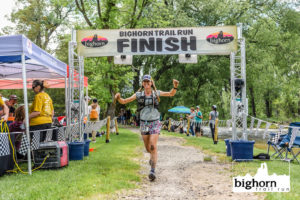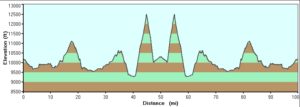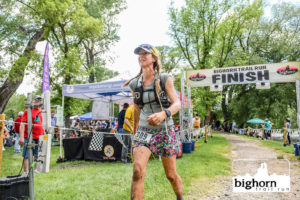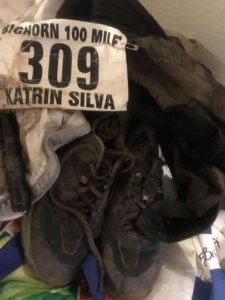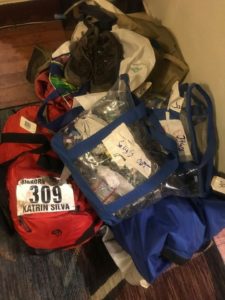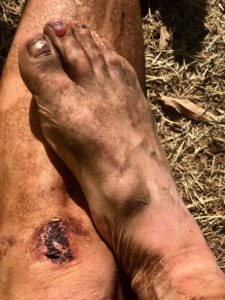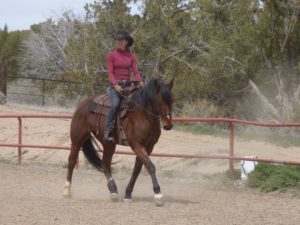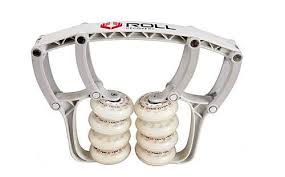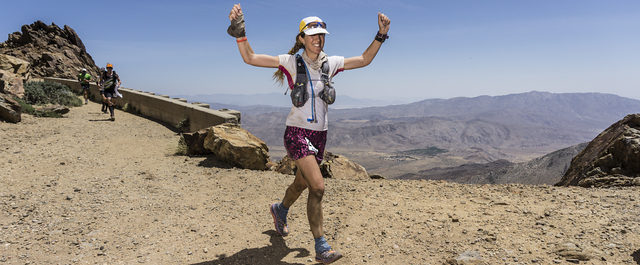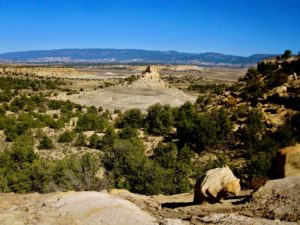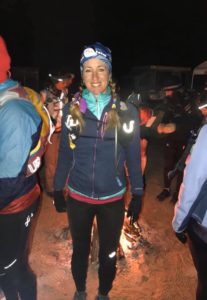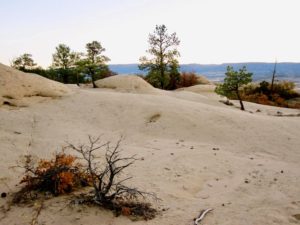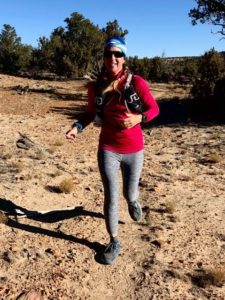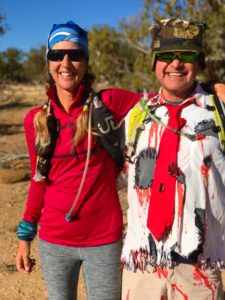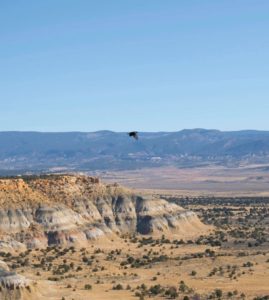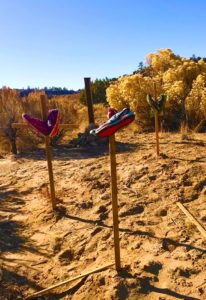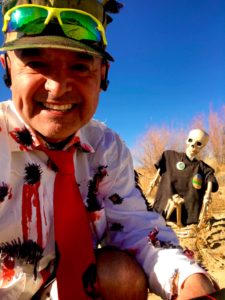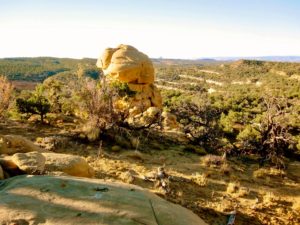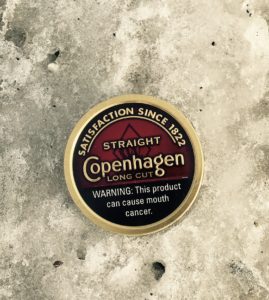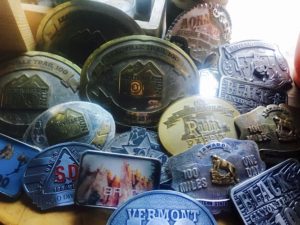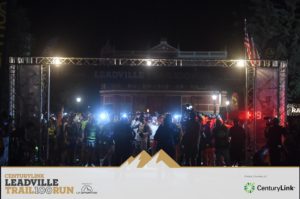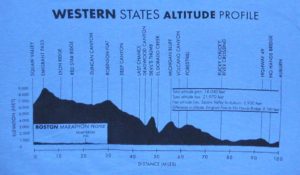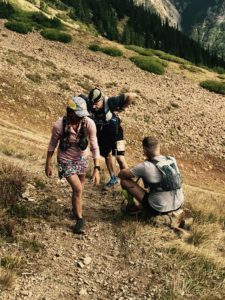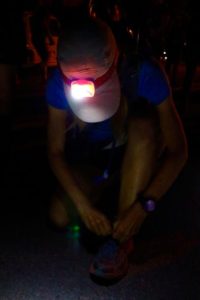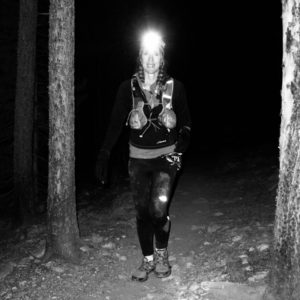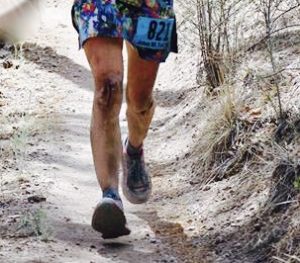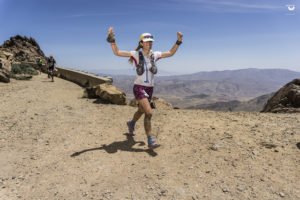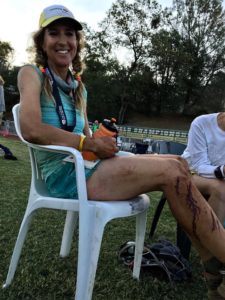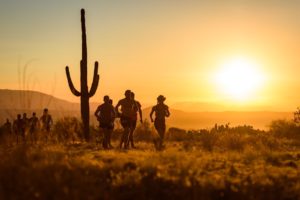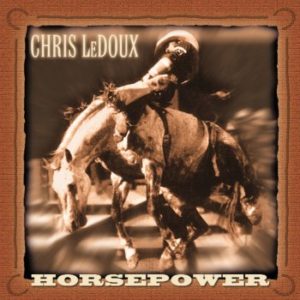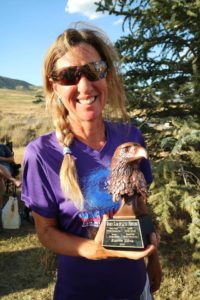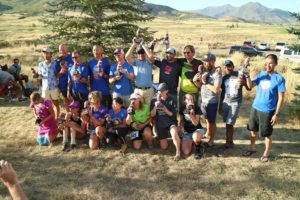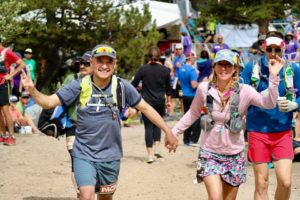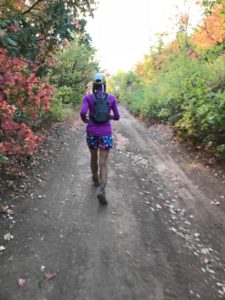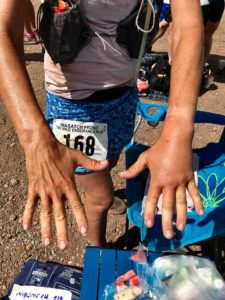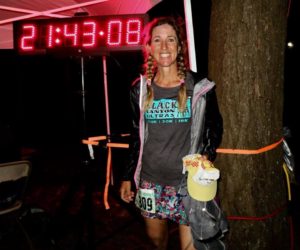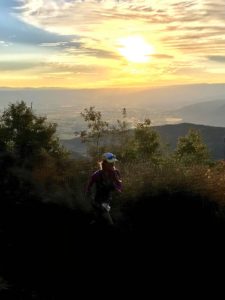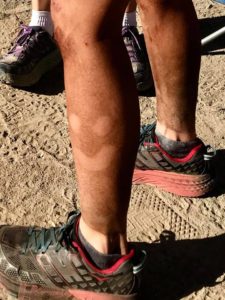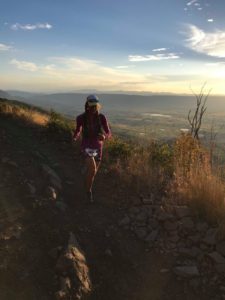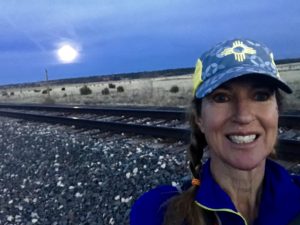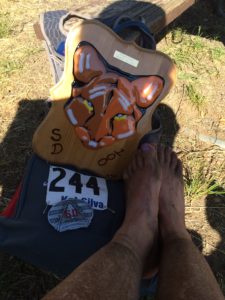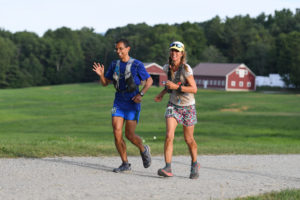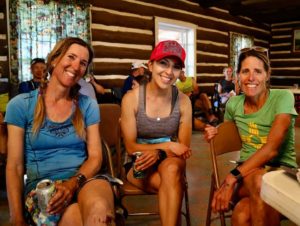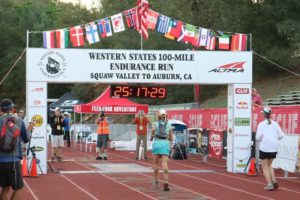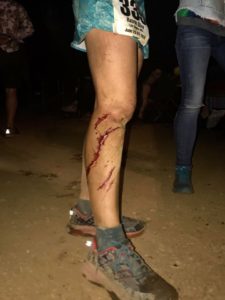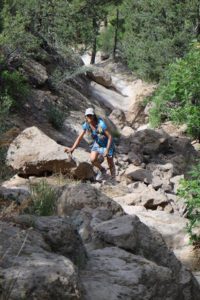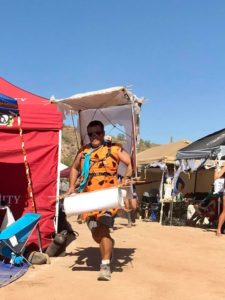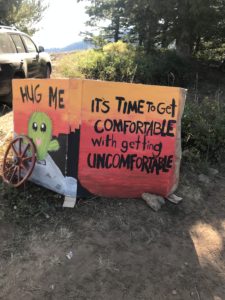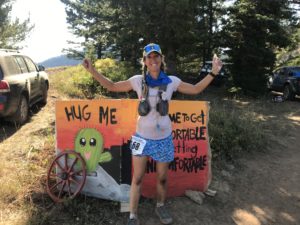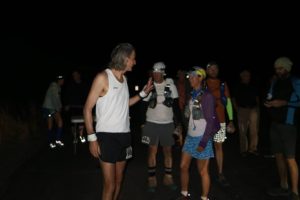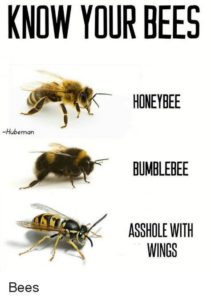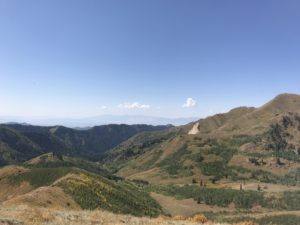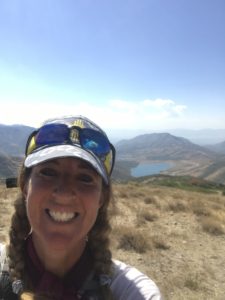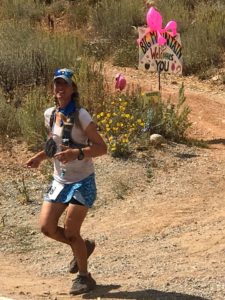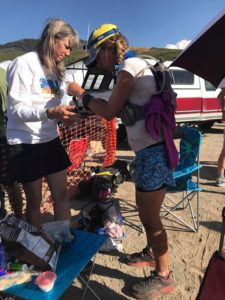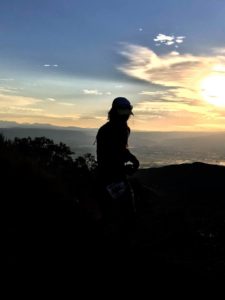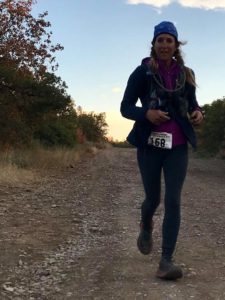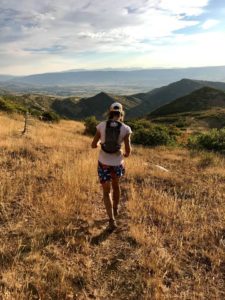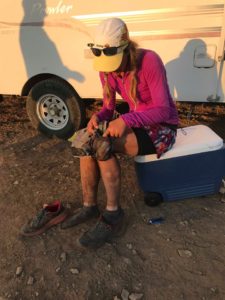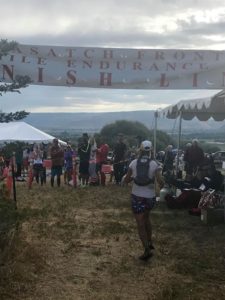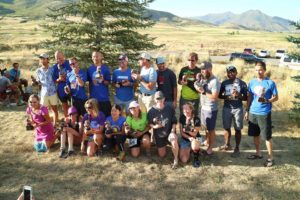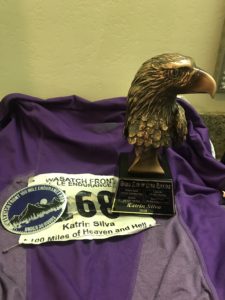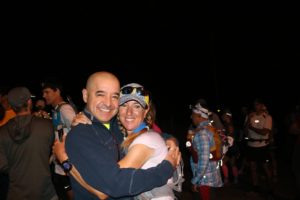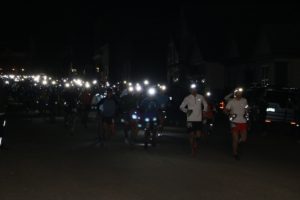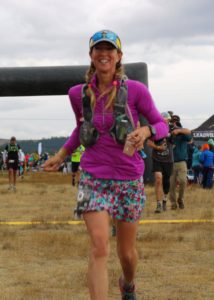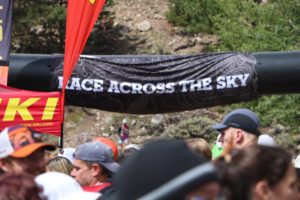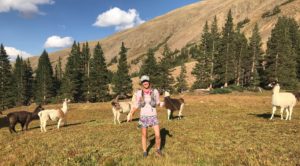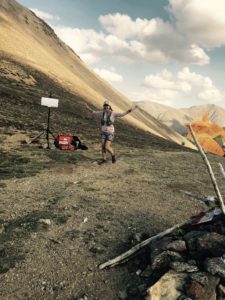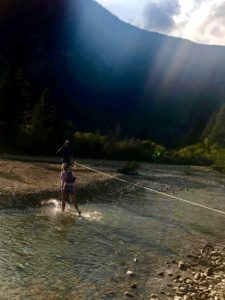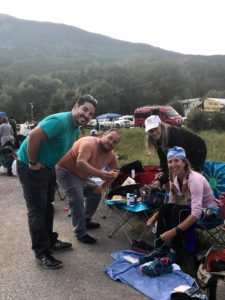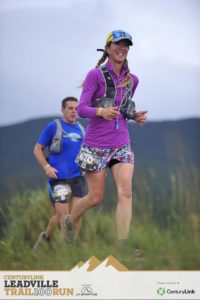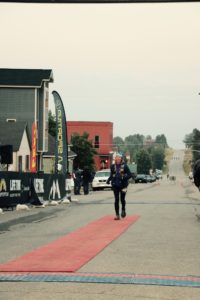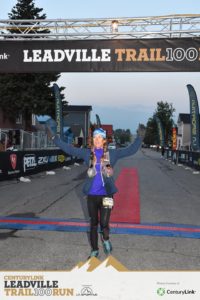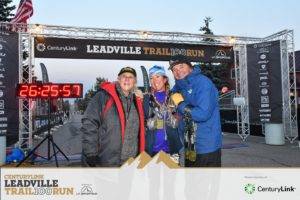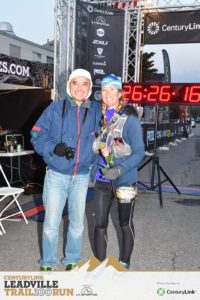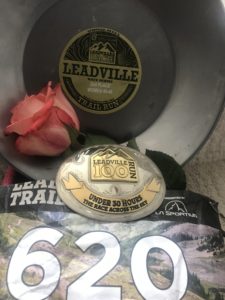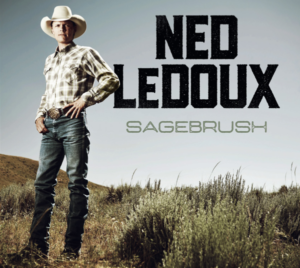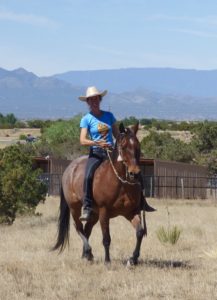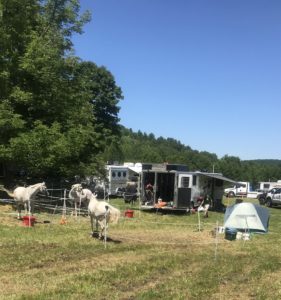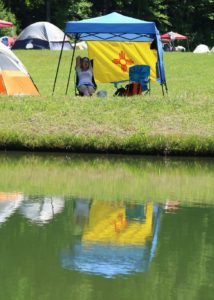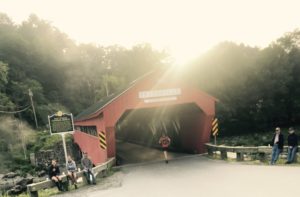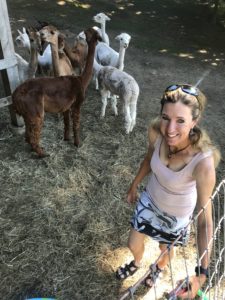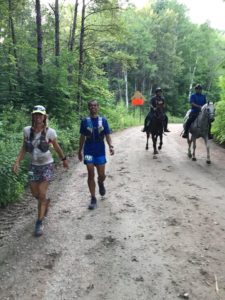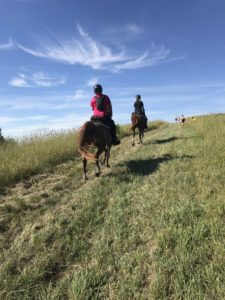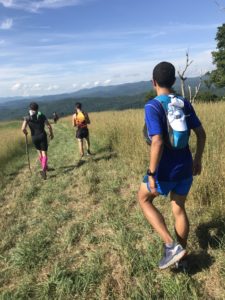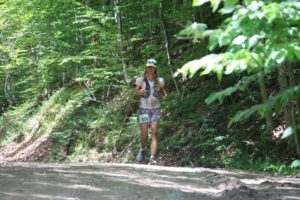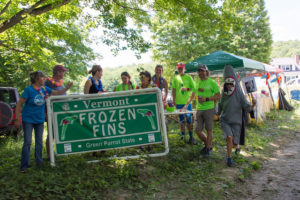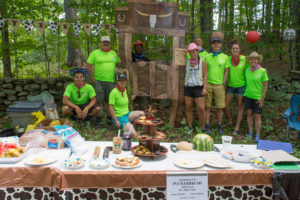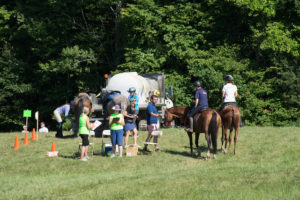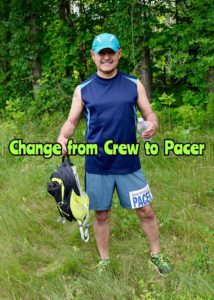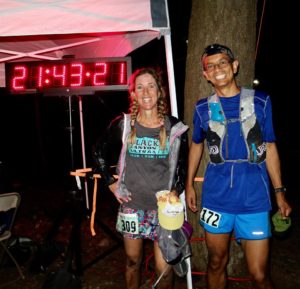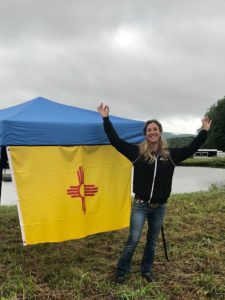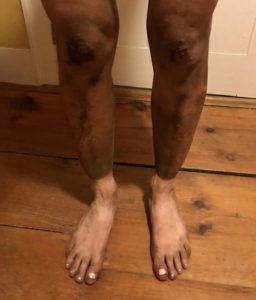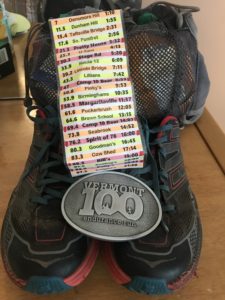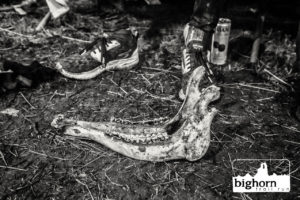
A dead horse, or one of last year’s 100-mile runners? My vision of Bighorn until this year.
I am not a coward. I’ve completed seventeen 100-mile races, including the Grand Slam of ultra running last year. But until this year, I was terrified of the Bighorn 100.
The horror stories about this race mention heat, cold, steep climbs, mosquitoes, snow, rain, and all the other usual suspects. None of them scare me. What’s always kept me from signing up is the mud, which tends to cover much of the Bighorn course: Mud that sucks your shoes off. Mud that makes forward progress difficult. Slippery mud. Sticky mud.
I don’t like running in mud. It’s demoralizing, It’s slow. It’s poison for my happy spirit. I have a hard time staying vertical even without it, so don’t need the added challenge of balancing in slippery conditions. But this year, I decided to face my fears and cross the Bighorn 100 off my bucket list. Besides, some friends reasoned, this race has been crazy muddy the last couple of years, so this year will surely be a dry one. I have no idea why their flawed logic convinced me to sign up, but here I am, on Friday, June 14, in Dayton, Wyoming, at 9 am, starting the Bighorn 100. Because these 100 miles with 17 000 feet of elevation gain are not enough of a challenge, I am running them solo, without crew, without pacer. My friends were, of course, wrong: rain is in the forecast, and snow covers the high country near the turnaround. Course conditions are so challenging this year that the race director allows us 35 hours to finish, instead of the usual 34. It’s too late to wimp out, so I’m starting with a simple plan: I will give this race my best shot.
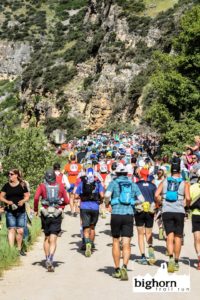
And we’re off, into the Bighorn Mountains – 346 of us, plus Matt’s ashes.
We head up a long, steep climb for the first 13 miles or so, hiking into the mountains through fields of wild flowers. “We” means 346 living, breathing ultra runners, plus the ashes of another.
I never met Matt Watts. He finished the Bighorn 100 nine times, but died just before he could finish his tenth. During the pre-race briefing, Matt’s widow and the RD draw a random name and hand a random runner Matt’s number, plus a little bit of his ashes: “We want you to hand him off to someone else at the first aid station” they explain. The plan is to repeat this process often, to let Matt finish his 10th Bighorn 100 posthumously, traveling along with a random bunch of us, like just another of the friends you meet while running an ultra. Our tough crowd of 100-mile runners tears up over this moving tribute. Matt’s ashes make me feel lucky to run this race, mud and all.
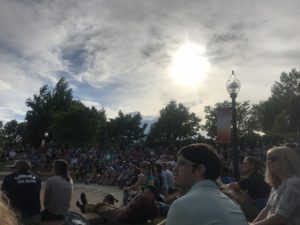
The pre-race briefing. Many of us were moved to tears when RD Michelle explained the logistics of Matt Watts’ memorial
After the Dry fork aid station, mile 15, the first rain shower of the day soon produces the infamous mud: Orange mud, yellow mud, brown mud in all sorts of shades.
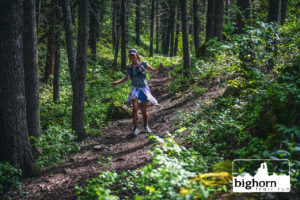
On my way to Sally’s, mile 30 or so
I slip-slide down the steep mountain also known as The Wall and reach Sally’s Footbridge at 4 pm, still feeling good, still ahead of schedule. I change my socks, pack my night stuff, grab some potato chips and head out again in five minutes flat. A volunteer checks I have all the mandatory clothes and gear, gloves, tights, lights, etc, before I head out into the really remote section of the course for the next 17 uphill miles. I feel smug about being so well organized. About a mile later, I realize I forgot to pack extra food. I have to survive until the Jaws aid station at mile 50 on two Stinger waffles, plus whatever calories I can get from the two remote aid stations that pack supplies in on horseback.
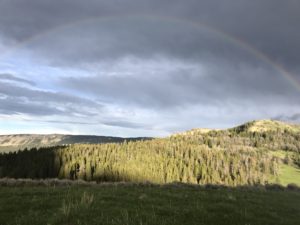
Wild, beautiful Wyoming.
The climb up to Jaws is jaw-dropping. Spectacular rock formations glow pink in the evening light. logs lead us across mountain streams. A double rainbow rises over a field of flowers. There is no sign of human civilization, other than the narrow single track trail and the occasional glimpse of another runner in the distance.
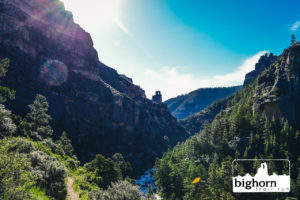
Horses and a mule named Reba have hauled supplies to the two aid aid stations between Sally’s and Jaws. Lucky for me, these supplies include pretzels and candy bars.
The sun has come out again, drying the mud. I begin to think the reports of bad course conditions were exaggerated. As the sun sinks behind the horizon, I look forward to running down this mountain on my way back from Jaws.
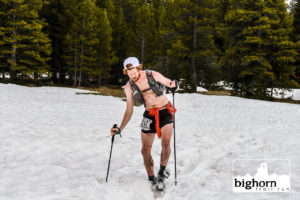
I came through here in the dark. It was even more treacherous then.
Snow starts covering the trail just as it’s time to turn on my lights. No, all the dire warnings were not exaggerated at all. My ground speed slows to a crawl. I sink into snow and the icy water below it, a few times all the way to my hips. My feet feel like mystery meat from the freezer. About a mile from the turnaround, the trail turns into a sloshy dirt road. A familiar silhouette comes toward me – Yuichiro Hidaka, my grand slam buddy from last summer, on his way to a strong finish. We hug, then he runs back down the mountain, shoes squishing, just as I reach the top.
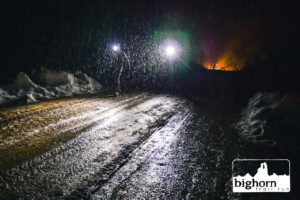
Mile 50, 10:15 pm
10 pm. I walk through the flaps of the big tent at Jaws into an oasis of warmth and light. I was planning on flying solo at Bighorn, without crew or pacer, but my friend Tammy’s crew, K’Ann and Vickie, are meeting me here. I did not expect this. It feels good to see familiar faces. They help me bundle up for the night as thunder grumbles around us. I head out, straight into a mountain storm.
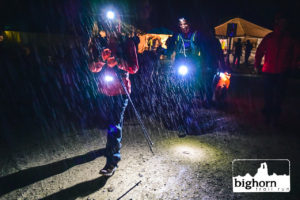
Rain pours from the dark sky, turning the trail into slippery mess. Lightning flashes over my head. Thunder rolls. My shoes have no traction whatsoever. I slide, I fall. I get back up, fall again. I fall about 50 times more. I fall on sharp rocks hiding under the mud. I cling to tree branches. Finally, the rain stops, though the mud stays. Paul from Boulder catches up to me. He carried Matt’s ashes to the turnaround point. I’ve never met Paul before, but we soon find ourselves in deep conversation about the meaning of life and the best and worst choices for 100-mile nutrition. A few muddy miles fly by in this enjoyable fashion, until he pulls ahead. Just like almost everyone else on this course, he carries trekking poles. I don’t, but by now I wish I had brought some.
My head lamp dims. Like a good girl scout, I am prepared. While pulling the extra batteries out of my pack with fingers clumsy from the cold, one AAA drops into the mud. I’ve brought my backup flashlight, but it’s not super bright, plus I keep falling and getting mud on it. Still, I cling to it, like to a life line.

Imagine balancing across this on a slippery log, in the dark, holding on to a tiny flashlight.
A guy with a long red beard catches up to me, introducing himself as Jeremy. Seeing my predicament, he reaches into his pack and hands me his extra head lamp which I promise to leave in his drop bag at Sally’s. Unfortunately, he does not have a spare set of trekking poles, but the light makes a big difference. People like Jeremy are the backbone of ultra running, one of the reasons I love this sport. Humbled and thankful, I trudge on, through footing that continues to get worse. I slosh through water. I wade through swampy meadows. The next three miles take me over an hour.
Back at Sally’s Footbridge. Mile 66. It’s now Saturday, June 15th, 4 am. I feel demoralized. It’s still dark. It’s still cold. It’s still wet. I am soaked, shivering, muddy, miserable, exhausted. I sink into a chair and spend way too much time fiddling around. I change socks, slap band-aids on a few of my blisters, slather on sunscreen on top of the mud on my arms and legs. I riffle through the ziploc baggies inside my drop bag, not finding what I’m looking for, because what I’m really looking for is a reason to quit. Getting back up seems impossible. I know another steep, slippery climb looms ahead. I want to cry. I can’t imagine ever leaving that chair. I want this nightmare to be over.
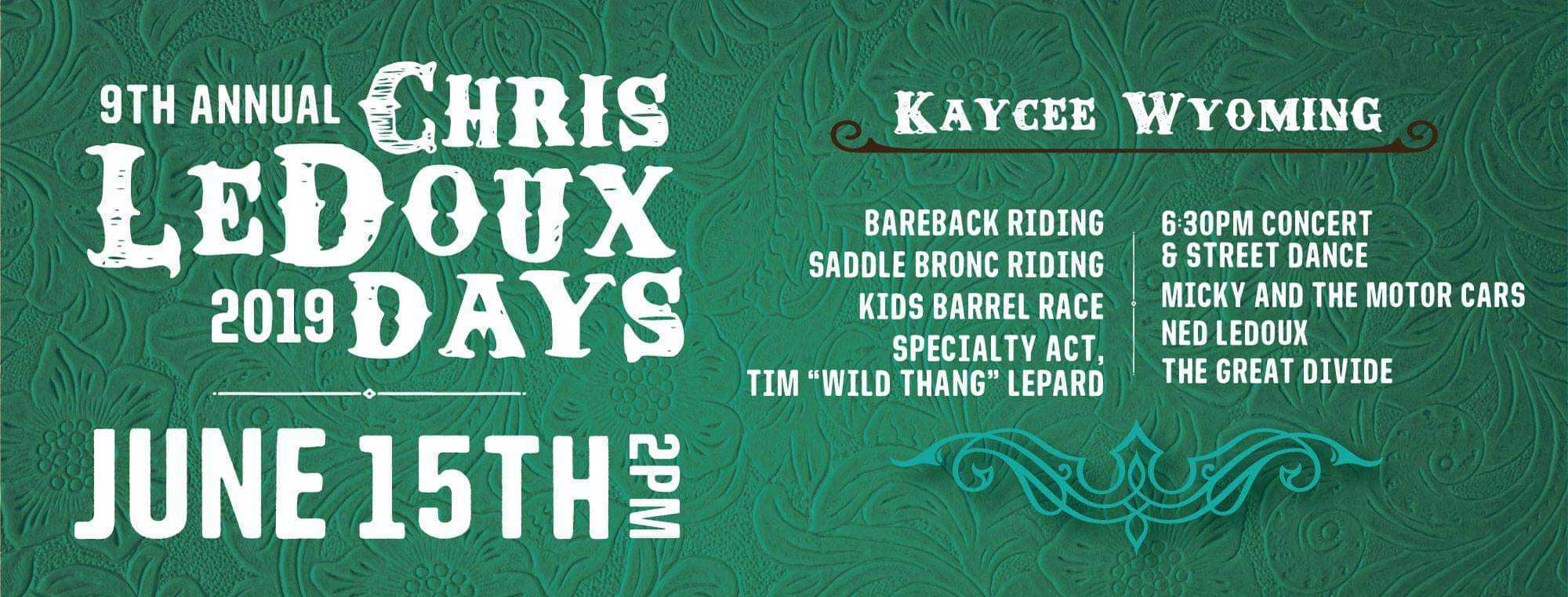
On my mind at 4 am, mile 66. I’m sure it was good, but I’m glad I finished the Bighorn 100 instead.
I could turn in my number. I could be done. I could catch a ride back to Dayton. I could get warm and clean and dry. I could take a shower, take a long nap, drive an hour to Kaycee and get there in time for the Chris LeDoux Days festivities Saturday evening. I could rest, sleep, and still listen to some really good live music. Not a bad plan. I’m almost 49 years old – too old for 100-mile mud runs. I’m a grown woman. I can make my own decisions. I don’t have to crawl through the mountains in the middle of nowhere for another 34 miles. The more I think about it, the better it sounds. Everyone I know would understand.
Or would they? And even if they did, would I enjoy that concert, knowing deep down that I failed to give this race everything I had in me? I think of Matt’s ashes, traveling along the course with one of us. Matt’s ashes, Matt’s spirit, but not his living, breathing body. I am here, hurting and miserable, but alive. I can’t let Matt down.
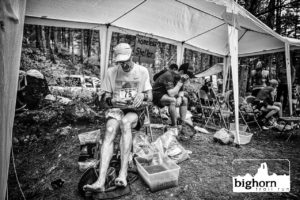
Sally’s Footbridge. It really looked and felt like a homeless shelter. A very welcoming one.
One of the volunteers is a young girl, about thirteen or so. Her eyes wide, her tired face serious, she asks if she can get me anything to eat, an EggMcMuffin, maybe? So the rumor that Bighorn serves McDonald’s at aid stations is true. I can’t remember the last time I ate anything from McDonald’s, but, just to procrastinate, I say yes, please. The McMuffin arrives, oozing artificial colors and pure comfort. It’s the most beautiful thing I’ve ever seen. I ask the smiling, Mc-Muffin-bearing teenager why she’s choosing to spend her weekend at this aid station, helping people her parents’ age reach the pointless goal of running through 100 miles of slop. She says she wants to be just like us when she grows up. I still want to cry, but decide I can’t. I can’t let this kid down. Three bites of McMuffin are all I can swallow, but they bring me back to life.
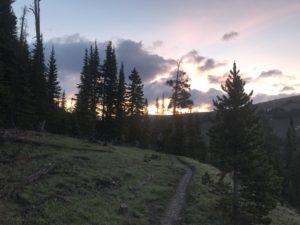
Daylight, beautiful daylight.
I strap on my pack, preparing for the now inevitable process of getting up and leaving that aid station. Music might be a good idea. I put on my head phones for the first time in this race and hit shuffle. Motivation from my favorite cowboy troubadour hits me spot-on: “I’d gladly take ten seconds in the saddle for a lifetime of watching from the stands . . . “ A good reminder of why I’m out here instead of in a warm bed. I could make it to Kaycee in time to watch a concert from the stands, but it would be wrong. It would be like bailing off the bucking horse after six and a half seconds instead of going for eight. I will make my own Chris LeDoux days happen right here. My place today is out on this trail, hanging on for as long as I can. My place is with Matt’s ashes, with Paul, with Jeremy, with my friend Tammy who just started the 50-mile race, with her friends who so graciously double as my crew, with all the other runners, with the bright-eyed kid and all the other volunteers, on that brutal course, doing what I came here to do until I’ve used up every last shred of grit and try.
I hike out, across the footbridge and back into the darkness, up the next climb aka The Wall, leaving the temptation to quit behind me
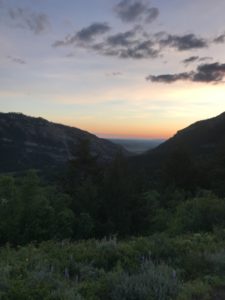
Worth it all. Definitely.
The Wyoming sunrise, just a short while later, is worth it all – all the pain, all the bruises, all the blisters. I hit my stride again. It’s still muddy, but I start passing people. One of them is Paul, who looks almost as green as the shirt he’s wearing, dealing with stomach issues. My stomach behaves like a trooper in comparison. I even take a piece of bacon from the famous bacon aid station. The sun dries out my clothes. I feel pretty human, except for my shredded feet. They hurt, but I can still run, so I do.
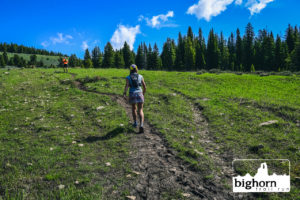
On my way back to Dry fork, fortified by bacon.
Back at Dry Fork, K’Ann and Vickie are excited to see me. Only 17 miles to go. Jeremy is sitting in a chair, looking spent, but not giving up. I am motivated enough to push for a sub-30 hour finish. Do I have time to put on the dry shoes waiting in my drop bag? I’ve been looking forward to them all day, so yes. The girls help me as precious minutes tick by.
13 miles of steep downhill make my toes and feet hurt even more than they already do. I wonder whether I can still finish in under 30 hours. It will depend on the pain level I’m able to tolerate. I walk for a bit, catching up to a guy from Texas and his pacer. The 18-mile and 50k runners are blazing by us stumbling 100-mile zombies.
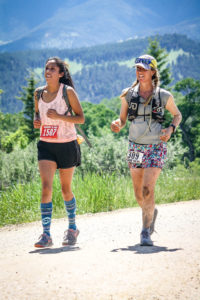
Shared misery is half the misery. Mile 97.
I force my aching feet back into a shuffle. It doesn’t hurt much worse than walking. I pass a few people who move even slower than I do. Finally, the bottom of the mountain. Finally, the bridge where we started yesterday morning, a lifetime ago. One more aid station. It’s 5.5. miles to the finish from here. 5.5 miles on a flat dirt road. No more mud, no more steep downhill, no more single track acrobatics trying to get out of the way of the 50k sprinters. It’s getting hot, but I’m almost home.
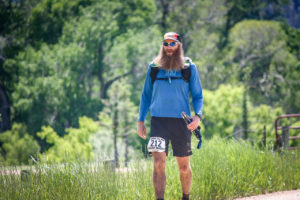
Jeremy, my headlamp hero, on the home stretch.
Out of nowhere, Paul passes me, back from the dead, looking strong again. I can’t keep up. My watch says sub-30 is still possible, but I will have to skedaddle. Doing math in my head is really hard at mile 96. My mushy ultra brain figures out I have an hour and 20 minutes to get it done. Shuffle, walk, shuffle. I catch up to Erik, another 100-mile runner stumbling along the road, and motivate him to start running again. Three more miles, and an hour to finish in sub-30. I could just walk the rest, but don’t want to cut it too close. Walk, shuffle, walk. The sun is high in the sky. My feet feel like raw hamburger meat. Every step is agony, but every step brings the finish line closer. Erik rallies. I can’t keep up with him anymore, but I’m still shuffling along. I catch up to a girl running the 18-miler. She looks like she’s about to cry, like I was at mile 66. We talk. We walk. We shuffle – to the next fence post, to the next tree, to the next big rock. Walk, shuffle, walk. I eventually pull ahead. The first houses. Two more miles. Families stand in their driveways, cheering, high-fiving. Children offer us popsicles, which taste like heaven.
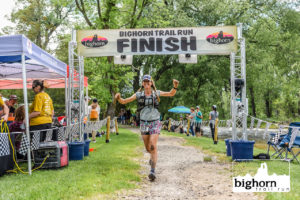
One last surge of adrenaline pushes me across the finish line. Nothing feels better than this. Nothing.
A paved road. A bridge. A sidewalk. I start running. I want to laugh. I want to cry. I want to hug everyone I see. Scott park. More people. They see my light brown (formerly white) number and recognize what that means. “A 100-miler!” Cheers. Music. I run what feels like (but probably wasn’t) an all-out sprint for abut ten strides, across the finish line. The clock says 29:41, good enough for 5th woman. K’ann and Vickie are waiting for me, hopping up and down, like cheerleaders. Paul and Erik are here, Jeremy arrives soon after, and the runner from Texas. We hug, we shake hands, we smile. We look like hell, but from underneath all the dirt and sweat, we radiate joy.
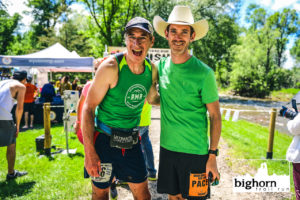
Paul from Boulder, happy to be done.
The adrenaline that pushed me across the finish line wears off about five minutes later. I sink down into the soft grass and close my eyes. Happy noise washes over me – announcements, music, laughter, dogs barking, a crescendo of cheers whenever a runner crosses the line. Right here, right now, is my favorite place in the world, ever.
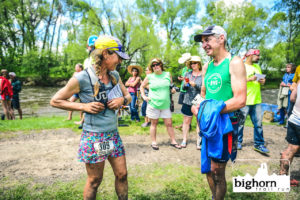
I know I have to get up eventually. I know I will have to move again at some point. To drain my blisters, to eat something, to rinse a few pounds of mud off my body. But all that can wait. I made it. I did not quit. I rode this beast of a course until the buzzer sounded.
I am almost 49 years old. In the not too distant future, there will be a time when 100-mile races become something I used to do. Today is not that day.
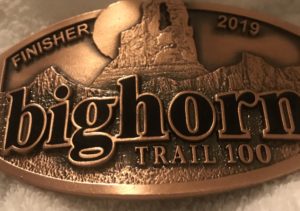
A hard earned buckle.
A huge thank you to the Bighorn race director and her team for organizing a first rate event. You did impressive work. Another huge thank you to my friend Tammy, for sharing her crew, and and to K’ann and Vickie, for doing double crew duty for someone they didn’t even know. Thank you, Paul, Erik, and everyone else I shared miles and conversations with. Thank you, Jeremy, for sharing your headlamp. Thank you, all the volunteers who sacrificed your weekend for us. Thank you, horses and mules, for carrying tons of aid station supplies into the remote parts of this course. And the biggest thank you goes posthumously to Matt Watts, for getting me out of that chair at mile 66. Matt, I never met you, but without you, I would not have finished.
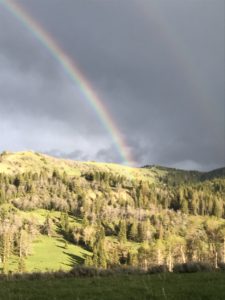
Like this:
Like Loading...
